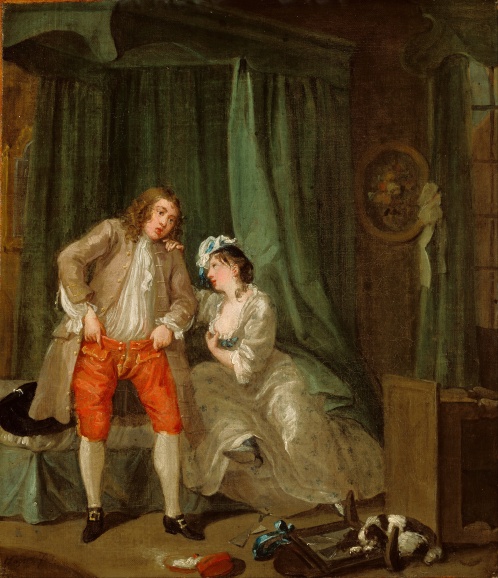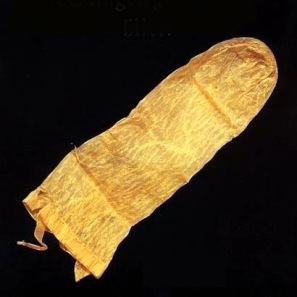
As you’re reading my series, you might notice that condoms (or “cundums”) are present. “Now, Jess,” you might be thinking to yourself, “I know you’re obsessed with contraception, but were people really using condoms in 1671?”
Yes, reader. Yes, they were.
The invention of modern condoms has been attributed to many people, and one of the front runners was Gabriele Fallopio (three guesses what he gave his name to) who recommended linen sheaths soaked in salt and herbs to prevent disease in his De Morbo Gallico (1564), a treatise against syphilis (translation: About the French Disease).
He was hardly the first person to use them for this purpose. Condoms have been used in various forms as far back as ancient Egypt (and beyond, if you believe that cave painting). By the Restoration, a Colonel Quondam, believed to have been a physician in the Royalist army, was rumored to have invented one made of animal gut for the notoriously amorous Charles II.
The first known mention of using sheep’s innards as a barrier method dates back to Minos, but we’ll let him have this one.
The process of producing condoms made of sheep intestines was lengthy. In The Sexual History of London, Catharine Arnold writes:

“(The) process involved soaking sheep’s intestines in water for a number of hours, then turning them inside out and macerating them again in a weak alkaline solution, changed every twelve hours. The intestines were then scraped carefully to remove the mucous membrane, leaving the peritoneal and muscular coats, and exposed to the vapor of burning brimstone. Next they were washed in soap and water, inflated, dried, and cut into eight-inch lengths. Finally, the open end was finished with a ribbon that could be tied around the base of the penis, and the condom had to be soaked in water to make it supple before use. After use, it could be washed and hung up to dry, ready for another excursion.”
Condoms became incredibly popular and were even lauded by the Earl of Rochester in 1667 as a protection against both disease and pregnancy in his Panegyrick Upon Cundums:
Happy the Man, who in his Pocket keeps,
Whether with green or scarlet Ribband bound,
A well made Cundum — He, nor dreads the Ills
Of Shankers or Cordee, or Bubos dire!”
Thrice happy he — (for when in lewd Embrace
Of Transport-feigning Whore, Creature obscene!
The cold insipid Purchase of a Crown!
Bless’d Chance! Sight seldom seen! and mostly given
By Templar or Oxonian — Best Support
Of Drury and her starv’d Inhabitants
He later died of syphilis.
Rochester definitely had the right idea, but at the time, there was a popular belief that venereal disease could not be spread between men, so some men took to entertaining themselves with their own sex to avoid disease, with small groups even swearing off women altogether. That sounds like a great excuse to me and will be the subject of an altogether different post.
But we’ll get there.
In the meantime, you can read Rochester’s Panegyrick Upon Cundums in its entirety here, and I recommend you do. It’s amazing. I’ll leave you with another little excerpt. Rochester makes a guest appearance in Tyburn, and Sally could be somewhere in this passage:
That when replete with Love, and spur’d by Lust,
You seek the Fair-one in her Cobweb Haunts,
Or when allur’d by Touch of passing Wench,
Or caught by Smile insidious of the Nymph
Who in Green Box at Playhouse nightly flaunts,
And fondly calls thee to Love’s luscious Feast,
Be cautious, stay a while ’till fitly arm’d
With Cundum Shield, at Rummer best supply’d,
Or never-failing Rose; so you may thrum
Th’ ecstatic Harlot, and each joyous Night
Crown with fresh Raptures; ’till at least unhurt,
And sated with the Banquet, you retire.
By me forwarn’d thus may you ever treat
Love’s pleasing Paths in blest Security.
Jessica Cale
Sources
Arnold, Catharine. The Sexual History of London: From Roman Londinium to the Swinging City—Lust, Vice, and Desire Across the Ages.
Fallopio, Gabriele. De Morbo Gallico.
Wilmot, John. A Panegyrick upon Cundums.
Previously published on authorjessicacale.com.

I can’t get over the fact that they washed them and then used them again eekkk.
LikeLike
I know! LOL And they had to soak them to make them more pliant before using. Not very appealing!
LikeLike
They were very smart to invent condoms, not just condoms but even sponges for women. Who would have ever thought of it if not for them then. But I still love how they called them French letters. Sounds very romantic, ironically.
LikeLike
Definitely! That is a rather romantic sounding term. It makes me think of all the terms for syphilis – the French pox, the Plague of Naples, etc – it’s always your neighbor, right? Now I’m curious about French euphemisms for condoms!
LikeLike
[…] note: For more on the contraception available in this period, check out this post on 17th century condoms. They were more of a protection against syphilis, and not a very effective one at […]
LikeLike
[…] Contraception in History V. “Love’s Pleasing Paths in Blest Security”: Seventeenth Century Condoms […]
LikeLike